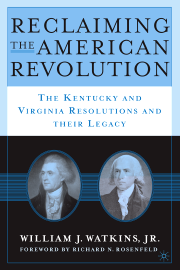Is the Pledge of Allegiance a prayer or a patriotic oath? Recently, the Supreme Court heard arguments on whether the words “under God” in the Pledge constitute an establishment of religion in public schools.
Lost in the legal commentary surrounding the case was a discussion of the merits of the Pledge. Even if saying the Pledge in public schools does not constitute an establishment of religion, why should we force schoolchildren to repeat it day after day? The answer seems to be that the Pledge has been around since 1892, so there is no need to question its use. The Pledge is as American as Mom and apple pie.
Well, not really. Few Americans know that Francis Bellamy, a Christian socialist and extreme Nationalist, drafted the Pledge of Allegiance. Francis was the cousin of Edward Bellamy, author of the futuristic novel Looking Backward, which depicted a utopian, socialist Boston in the year 2000. The book gave rise to a Bostonian socialist movement known as “Nationalism.” A main objective of the Bostonian Nationalists was for the federal government to seize the means of production of the American economy.
Francis Bellamy, an officer in the Nationalist movement, was no stranger to conflict. His sermons on “Jesus the Socialist” and “The Socialism of the Primitive Church” prompted congregations to chase him from the ministry. Bellamy went on to work for Youth’s Companion, a national magazine with a circulation of approximately 500,000. The magazine launched a campaign to sell American flags to the public schools, and by 1892 had sold 26,000. In a brilliant marketing ploy, the magazine’s editors concocted a plan to sell even more flags in connection with the 400th anniversary of Christopher Columbus’ discovery of the New World. Enlisting the assistance of the National Education Association, a flag ceremony was made central to Columbus Day celebrations. In the program for the celebration, Bellamy included a pledge:
I pledge allegiance to my Flag and to the Republic for which it stands—one nation indivisible—with liberty and justice for all.
In the early 1920s, the National Flag Conference changed “my Flag” to “the Flag of the United States of America.” They did not want to run the risk that immigrants might be secretly pledging allegiance to the flag of another country. In 1954, at the height of the Red Scare, the Knights of Columbus persuaded Congress to add “under God” to the Pledge to differentiate the United States from the godless communists.
While the sale of flags was a key component of the Pledge, darker forces were also at work. Mass immigration and assimilation were issues in the late 1880s and the1890s. Nativists wanted to impress the duties of American citizenship on immigrant children in hopes of breaking any remaining bonds to their lands of origin. Also, with the Civil War still in recent memory, Northerners wanted to remind Southerners that the union was “indivisible.” The old union based on consent was dead and gone. The likes of Bellamy also believed that if Southern children recited over and over that the union was indivisible, they would eventually repudiate the acts of their ancestors and would never again try to assert a right of secession.
Viewed in light of this history, the Pledge does not look so warm and fuzzy. It was not much more than a marketing tool and a slap in the face to recent immigrants and Americans living below the Mason-Dixon line.
The use of the Pledge in schools is especially odious if we take oaths seriously. But small children can’t be expected to understand what they are pledging allegiance to, especially when it is a piece of cloth. (It’s worth noting that the only other country in the world that pledges allegiance to a flag is the Philippines, and as our former colony, they are simply mimicking our practice.) Moreover, to the extent that the flag stands for certain principles, we still cannot expect children to decipher or grasp these principles of “Americanism.”
If we want to teach children about this country’s principles, why not teach them about the American Revolution, the Constitution, and the Bill of Rights? Instead, each day they mindlessly pledge obedience to a flag–the most visible symbol of governmental authority. Thomas Jefferson once reminded his countrymen that such blind confidence in government “is every where the parent of despotism; free government is founded on jealousy and not in confidence.”
The ritual of schoolchildren saying the Pledge is unbecoming for a nation of free people. Jealousy of liberty—in the face of government claims to power—is a civic virtue, and one that our nation’s founders urged us not to forget. After 112 years, it is time that we rethink our use of Bellamy’s Pledge of Allegiance.











